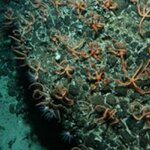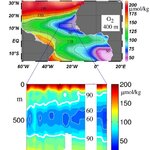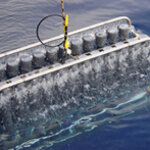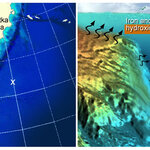Oceanography

The snowball Earth hypothesis posits that the Earth was covered from pole to pole in a thick sheet of ice for millions of years at a time. 635 million years ago, an abrupt release of methane from ice sheets that extended to Earth's low latitudes spiked global warming and ended the last "snowball" ice age, say researchers. The researchers believe that the methane was released gradually at first and then very quickly from clathrates - methane ice that forms and stabilizes beneath ice sheets.
Also called marsh gas, methane is a colorless, odorless gas. As a greenhouse gas, it is about 30 times…

An international team of scientists surveying the waters of the continental shelf off the West Coast of North America has discovered for the first time high levels of acidified ocean water within 20 miles of the shoreline, raising concern for marine ecosystems from Canada to Mexico.
Researchers aboard the Wecoma, an Oregon State University research vessel, also discovered that this corrosive, acidified water that is being “upwelled” seasonally from the deeper ocean is probably 50 years old, suggesting that future ocean acidification levels will increase since atmospheric levels of carbon…

Since the 1980’s Dr. Joseph M. Prospero, professor of Marine and Atmospheric Chemistry at the University of Miami’s Rosenstiel School of Marine and Atmospheric Science, has pioneered studies in the worldwide measurement of aerosols, fine particles suspended in the atmosphere and carried by winds.
His team’s work focuses on the aerosol chemistry of the marine atmosphere. They are particularly interested in the long-range transport of pollutants from the continents to the oceans and their impact on climate and on biogeochemical processes in ocean waters.
Starting in 1980 Prospero established a…

Census of Marine Life-affiliated scientists, plumbing the secrets of a vast underwater mountain range south of New Zealand, captured the first images of a novel “Brittlestar City” established against daunting odds on the peak of a seamount – an underwater summit taller than the world’s tallest building.
Its cramped starfish-like inhabitants, tens of millions living arm tip to arm tip, owe their success to the seamount’s shape and to the swirling circumpolar current flowing over and around it at roughly four kilometers per hour. It allows Brittlestar City’s underwater denizens to capture…

Marine scientists led by Dr. Lothar Stramma from the Leibniz Institute of Marine Sciences (IFM-GEOMAR) in Kiel, Germany say they have made an alarming new discovery - in some regions of the world oceans, oxygen essential for marine organisms is declining.
The new study documents that the oxygen values in tropical oceans at a depth of 300 to 700 meters have declined during the past 50 years. As large marine organisms can either no longer exist in these areas or they would avoid them, the expanding oxygen minimum zones may have substantial biological and economical consequences.
The oxygen…

Scientists at the Georgia Institute of Technology have discovered a new climate pattern called the North Pacific Gyre Oscillation.
This new pattern explains changes in the water that are important in helping commercial fishermen understand fluctuations in the fish stock. They also believe that as the temperature of the Earth warms, large fluctuations in these factors could help climatologists predict how the oceans will respond in a warmer world.
“We’ve been able to explain, for the first time, the changes in salinity, nutrients and chlorophyll that we see in the Northeast Pacific,” said…

While the recent Arctic summer was the warmest on record satellite images from the Antarctic summer have shown the largest sea-ice extent ever recorded, according to the Polarstern expedition. ANT-XXIV/3 was dedicated to examining the oceanic circulation and the oceanic cycles of materials that depend on it. Warming is a lot less global when you get south of Chile, it seems.
In the coming years autonomous measuring buoys will be used to find out whether the cold Antarctic summer induces a new trend or was only a 'slip.'
Under the direction of Dr. Eberhard Fahrbach, Oceanographer at the…

In oceanography studies, the iron needed to fertilize infrequent plankton blooms in High Nutrient, Low Chlorophyll (HNLC) regions was assumed to come almost entirely from wind-blown dust.
That's not the case in the North Pacific, say Phoebe Lam and James Bishop of the Earth Sciences Division at the Department of Energy's Lawrence Berkeley National Laboratory
They report that the key source of iron in the Western North Pacific is not dust but the volcanic continental margins of the Kamchatka Peninsula and the Kuril Islands.
From a site at 47 degrees north latitude and 160 degrees east…

A new modeling approach using sea ice motion data to follow parcels of ice backward in time at monthly intervals for up to 3 years while accumulating a history of the solar radiation and air temperature to which the ice was exposed offers new hope for increased accuracy in climate change models, say scientists with the U.S. Geological Survey and the Russian Academy of Sciences, Moscow. This is the only model based entirely on historical observations.
Using this new technique, the thickness of Arctic sea ice was estimated from 1982 to 2003. Results showed that average ice thickness and total…

A team of scientists from Cardiff University’s School of Earth and Ocean Sciences and Amgueddfa Cymru - National Museum Wales travelled to Africa to find new evidence of climate change which helps explain some of the mystery surrounding the appearance of the Antarctic ice sheet.
Ice sheet formation in the Antarctic is one of the most important climatic shifts in Earth’s history. However, previous temperature records show no evidence of the oceans cooling at this time, but instead suggest they actually warmed, presenting a confusing picture of the climate system which has long been a mystery…